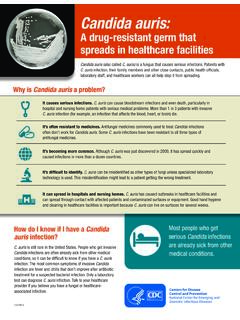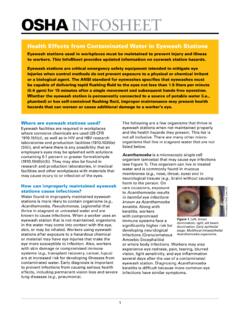Transcription of FAQ's about Catheter-Associated Bloodstream Infections
1 FAQs(frequently asked questions) Catheter-Associated Bloodstream Infections (also known as Central Line- associated Bloodstream Infections ) about What is a Catheter-Associated Bloodstream infection? A central line or central catheter is a tube that is placed into a patient s large vein, usually in the neck, chest, arm, or groin. The catheter is often used to draw blood, or give fluids or medications. It may be left in place for several weeks. A Bloodstream infection can occur when bacteria or other germs travel down a central line and enter the blood. If you develop a Catheter-Associated blood-stream infection you may become ill with fevers and chills or the skin around the catheter may become sore and red. Can a catheter -related Bloodstream infection be treated?
2 A Catheter-Associated Bloodstream infection is serious , but often can be successfully treated with antibiotics. The catheter might need to be removed if you develop an infection. What are some of the things that hospitals are doing to prevent Catheter-Associated Bloodstream Infections ? To prevent Catheter-Associated Bloodstream Infections doctors and nurses will: Choose a vein where the catheter can be safely inserted and where the risk for infection is small. Clean their hands with soap and water or an alcohol-based hand rub before putting in the catheter . Wear a mask, cap, sterile gown, and sterile gloves when putting in the catheter to keep it sterile. The patient will be covered with a sterile sheet. Clean the patient s skin with an antiseptic cleanser before putting in the catheter .
3 Clean their hands, wear gloves, and clean the catheter opening with an antiseptic solution before using the catheter to draw blood or give medications. Healthcare providers also clean their hands and wear gloves when changing the bandage that covers the area where the catheter enters the skin. Decide every day if the patient still needs to have the catheter . The catheter will be removed as soon as it is no longer needed. Carefully handle medications and fluids that are given through the catheter . What can I do to help prevent a Catheter-Associated Bloodstream infection? Ask your doctors and nurses to explain why you need the cath-eter and how long you will have it. Co-sponsored by: Ask your doctors and nurses if they will be using all of the pre-vention methods discussed above.
4 Make sure that all doctors and nurses caring for you clean their hands with soap and water or an alcohol-based hand rub before and after caring for you. If you do not see your providers clean their hands, please ask them to do so. If the bandage comes off or becomes wet or dirty, tell your nurse or doctor immediately. Inform your nurse or doctor if the area around your catheter is sore or red. Do not let family and friends who visit touch the catheter or the tubing. Make sure family and friends clean their hands with soap and water or an alcohol-based hand rub before and after visiting you. What do I need to do when I go home from the hospital? Some patients are sent home from the hospital with a catheter in order to continue their treatment.
5 If you go home with a catheter , your doctors and nurses will explain everything you need to know about taking care of your catheter . Make sure you understand how to care for the catheter before leaving the hospital. For example, ask for instructions on shower-ing or bathing with the catheter and how to change the catheter dressing. Make sure you know who to contact if you have questions or problems after you get home. Make sure you wash your hands with soap and water or an alcohol-based hand rub before handling your catheter . Watch for the signs and symptoms of Catheter-Associated blood-stream infection, such as soreness or redness at the catheter site or fever, and call your healthcare provider immediately if any occur. If you have additional questions, please ask your doctor or nurse.
6












